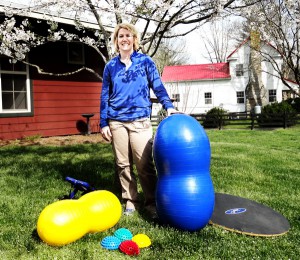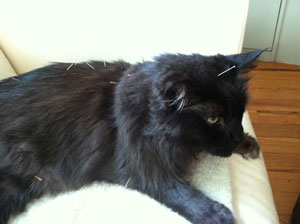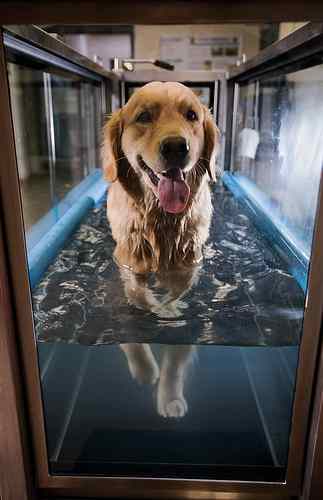 On Sunday, as part of our “Pet Matters” seminar series, Dr. Perkins gave an interesting and informative presentation here at The Farm on what she calls “complementary medicine.”
On Sunday, as part of our “Pet Matters” seminar series, Dr. Perkins gave an interesting and informative presentation here at The Farm on what she calls “complementary medicine.”
What is complementary medicine? Some may call this “alternative” medicine, but, as one of the vets at Animalia Health and Wellness, she still believes very strongly in the value and use of traditional veterinary practices and medications. She also believes–and can testify from experience–that there are other things that owners can do in addition to traditional medicine to:
- Alleviate pain
- Assist rehabilitation and recovery
- Promote strength and wellness
- Potentially reduce the need for medication or amount needed
Dr. Perkins focused on several different aspects of this complimentary medicine that she actively participates in at Animalia. These include:
- Therapeutic laser
- Electrical stimulation
- Acupuncture
- Therapeutic exercises
- Active Motion
- Aquatic Therapy
- Chiropractic
Therapeutic Laser
Dr. Perkins showed examples of how this tool had effected healing in wounds that would normally heal slowly, or not at all. The laser is so effective because it sends energy deep into tissues, where it stimulates blood flow, which in turn creates better healing by bringing nutrients and energy to damaged areas. The laser can also reduce pain (Dr. Perkins has used it on her own back!) and heal persistent infections such as lick granulomas.
Electrical Stimulation
Dr. Perkins uses two types of nerve stimulation. TENS (transcutaneous electrical nerve stimulation) is helpful in reducing pain. NMES (neuromuscular electrical stimulation) is very effective in preventing muscle atrophy while a patient recovers from surgery or injury.
Acupuncture

Trained in “medical acupuncture,” Dr. Perkins has found the use of acupuncture to be useful to rehabilitate and help animals in many ways. It is so effective because the tiny needles–which are not at all painful but, in fact, often cause the patient to relax incredibly–stimulate nerves, reminding muscles how they should work, and relieving pain and strain in critical areas. She has seen issues such as incontinence improved, and she has helped many patients regain lost mobility and function, even reversed paralysis. It can even help arthritis, allergies, respiratory issues, G.I. symptoms, and tear production.
Therapeutic Exercises
Not only does Dr. Perkins perform these exercises on pets, but she also teaches their owners how to do these exercises. She is very careful to evaluate the patient’s “passive range of motion” so that exercises can be performed within the limits of comfort–causing no pain–and helping strengthen the patient, particularly during recovery after surgery.
Active Motion
This consists of many different elements–balance board, therapy ball, cavaletti rails, the treadmill, and exercises like “dancing” and “wheelbarrowing”–which Dr. Perkins can tailor to a pet’s specific needs, aiding balance, strengthening specific areas. She also gives us a wonderful bit of advice:
Keep your pet moving every two hours! This is not as important
when your pet is young, but when they get older, this regular
stimulation definitely helps keep an animal more active and
feeling better.
 Aquatic Therapy
Aquatic Therapy
Animalia is the only facility in the area that offers an underwater treadmill for small animals (from cats to Great Danes). Dr. Perkins explained that aquatic therapy can be vital for recovery in several ways. First of all, the pressure of the water, much like laser therapy or acupuncture, provides stimulation to areas of the body which may be atrophied or stagnant. Additionally, the bouyancy of the water can enable animals who would not normally be able to stand or balance to do these things so that they can work toward recovery and standing and walking on land. The action of walking against the resistance of the water is also very good for strengthening weak muscles.
Chiropractic
Dr. Perkins does not currently offer veterinary chiropractic, but she is being certified in this field, and you will see this integrated into Animalia’s program soon!
Conclusion
If you find yourself in a situation where your pet is injured, debilitated, or recovering from surgery, there are many options for helping your pet move toward a state of well-being in tandem with traditional medicines and therapies.
Dr. Perkins is always willing to work with your current vet to achieve the best possible results for your pet. She also knows that each pet is different, and the road to recovery is different for each…but often situations are not as dire as they seem, and with patience and persistence and willingness to try these new and exciting options in complementary medicine, amazing results can be achieved!


